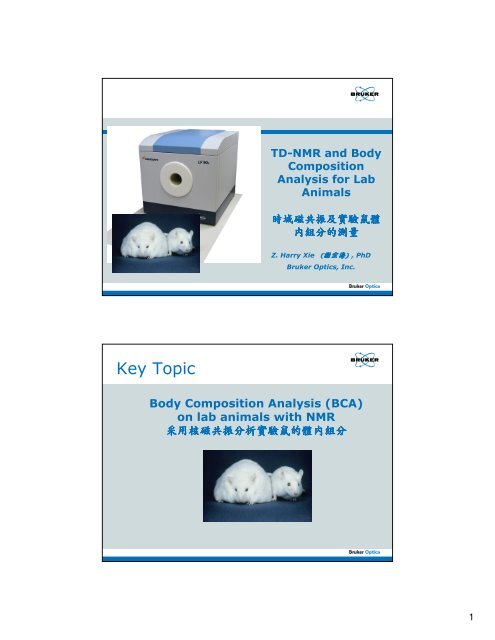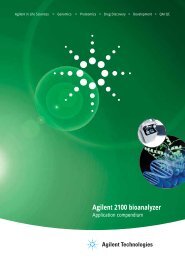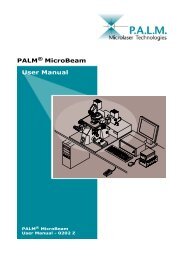LF90II Characteristics
LF90II Characteristics
LF90II Characteristics
Create successful ePaper yourself
Turn your PDF publications into a flip-book with our unique Google optimized e-Paper software.
Key Topic<br />
TD-NMR and Body<br />
Composition<br />
Analysis for Lab<br />
Animals<br />
时域磁共振及实验鼠体<br />
时域磁共振及实验鼠体<br />
内组分的测量<br />
内组分的测量<br />
Z. Harry 谢宗海), PhD<br />
Bruker Optics, Inc. 谢宗海<br />
Xie(谢宗海<br />
Body Composition Analysis (BCA)<br />
on lab animals with NMR<br />
采用核磁共振分析实验鼠的体内组分<br />
采用核磁共振分析实验鼠的体内组分<br />
1
BCA on Mice and Rats 实验鼠体内组分分析<br />
实验鼠体内组分分析<br />
Body Composition is a BioMarker<br />
(body weight often not)<br />
Animal Models (Mice & Rats) for:<br />
• Diabetes & Obesity Research<br />
• Dietary Analysis<br />
• Gene Knock-Out Mice<br />
Requirements:<br />
•Routine & Quick Method<br />
•Compatible to Animal House<br />
•Low animal health risk<br />
(longitudinal studies)<br />
•Method for Mice & Rats<br />
Lean<br />
Current Methods for BCA on Mice and Rats 实验鼠体内组分分析现行方法<br />
Dissection 解剖<br />
解剖<br />
DEXA (Dual Energy X-Ray Absorption)<br />
双能量 双能量X光吸收<br />
双能量 光吸收 光吸收<br />
NMR/MRI 磁共振或磁共振成像<br />
磁共振或磁共振成像<br />
TD-NMR 时域核磁共振<br />
时域核磁共振<br />
Fat<br />
Free Fluid<br />
2
DEXA Method方法 方法 方法<br />
Dual Energy X-ray Absorption<br />
(also DXA)<br />
• Harmful radiation<br />
• Requires Anesthesia<br />
• Animals don’t eat following scan<br />
• Only 1 scan per week (rats)<br />
• overlap bone, tissue (2D scan)<br />
• ID Chips not possible<br />
TD-NMR Method 时域核磁共振方法<br />
时域核磁共振方法<br />
2. Loading<br />
3. Inserting<br />
1. Weighing<br />
3
TD-NMR BCA History<br />
First Mouse Systems<br />
Introduced in USA in<br />
2001 (mq-7.5, LF50)<br />
First Rat Systems<br />
Introduced in USA in<br />
2004 (LF90)<br />
The 2nd Generation BCA Analyzer:<br />
the minispec <strong>LF90II</strong><br />
Introduced ISMRM May 2007<br />
Press Release Pittcon 2008<br />
(with capability of measuring<br />
rats up to 850g body weight)<br />
4
When we talk about N.M.R.<br />
BCA by TD-NMR<br />
Body Composition Analysis (BCA)<br />
with the minispec<br />
bench-top TD-NMR<br />
…NMR spectrum or MR Image will come to our mind.<br />
But TD-NMR does not deal with the above<br />
5
What is TD-NMR?<br />
Time Domain Nuclear Magnetic Resonance;<br />
Benchtop NMR;<br />
Low Resolution NMR;<br />
Low Field NMR;<br />
QC type NMR analyzer;<br />
Non-spectroscopic NMR;<br />
Relaxometry;<br />
TD-NMR History<br />
2nd generation (1972) 4th generation (1983) 5th 3 generation (1993)<br />
rd generation (1980)<br />
6 th generation<br />
(1999)<br />
New Additions<br />
(2008)<br />
6
NMR Nutshell<br />
NMR requires only very low energy radiation<br />
Where NMR signals come from?<br />
Any NMR-sensitive nucleus (such<br />
as hydrogen) has a positive<br />
electric charge and a nuclear spin.<br />
Together, these give the nucleus a<br />
magnetic moment, so that it<br />
behaves like a small magnet.<br />
A hydrogen nucleus is a small magnet<br />
6.2 MHz up to 60 MHz<br />
7
核磁共振信号的产生<br />
核磁共振信号的产生<br />
原子核,如氢核,即质子,具<br />
有两个很基本的物理属性—带<br />
有正电荷以及原子核自旋。由<br />
于这两个属性,原子核就具有<br />
磁矩。因此,原子核的行为在<br />
某种程度上就象小磁体。<br />
一个氢核就是一个小磁体<br />
一个氢核就是一个小磁体<br />
核磁共振信号的产生<br />
核磁共振信号的产生<br />
在自由空间中,原子核小磁体<br />
的指向是随机和无规则的。<br />
当处于外加磁场中,原子核要<br />
当处于外加磁场中,原子核要<br />
受外场磁力的作用,重新分布<br />
受外场磁力的作用,重新分布<br />
小磁体的指向。并且,由于受<br />
小磁体的指向。并且,由于受<br />
外加磁力矩的作用,原子核在<br />
外加磁力矩的作用,原子核在<br />
自旋的同时,还绕着外加磁场<br />
自旋的同时,还绕着外加磁场<br />
的方向作进动。<br />
的方向作进动。<br />
Field B<br />
S<br />
核磁共振 核磁共振 ω ω ω ω = γγγγB0<br />
N<br />
= = =<br />
8
Where NMR signals come from?<br />
RF Pulse Transient<br />
N S<br />
All frequencies in, Resonant frequency signal out<br />
核磁共振信号的产生<br />
核磁共振信号的产生<br />
获得核磁共振信号的条件:<br />
•发射和接收射频的装置; 获得核磁共振信号的条件:<br />
•<br />
获得核磁共振信号的条件:<br />
•<br />
•固定的外加磁场;<br />
核磁共振信号产生的原理 射频脉冲通过线圈改变核磁矩的方向;<br />
•样品<br />
圈中的磁通量发生变化; 核磁共振信号产生的原理<br />
转动的核磁矩作切割磁力线运动,使线<br />
• 流,即核磁共振信号。 与发电机工作原理相似<br />
磁通量的变化,在线圈中产生感应电<br />
Conditions for observing NMR signals:<br />
• A fix external magnet;<br />
• Devices for transmitting and<br />
receiving RF;<br />
• A sample.<br />
A RF pulse changes direction of spins in the<br />
sample inside a detecting coil;<br />
This leads to a change in magnetic flux in<br />
the detecting coil;<br />
Inducted current, i.e. NMR signal, is then<br />
produced in the detecting coil<br />
similar to an electric generator<br />
RF Pulse Transient<br />
N S<br />
All frequencies in, Resonant frequency signal out<br />
9
TD-NMR Signal<br />
Intensity<br />
100<br />
90<br />
80<br />
70<br />
60<br />
50<br />
40<br />
30<br />
20<br />
10<br />
T 2<br />
Solid (Crystalline phase)<br />
NMR Signal<br />
Liquid (Amorphous phase)<br />
0<br />
0.0074 0.0274 0.0474 0.0674 0.0874<br />
TD-NMR Signal<br />
Intensity<br />
100<br />
90<br />
80<br />
70<br />
60<br />
50<br />
40<br />
30<br />
20<br />
10<br />
time (ms)<br />
A. The first part of signal (intensity) is<br />
directly related to the number of nuclei<br />
in the sample (more NMR signal<br />
means more nuclei in the sample);<br />
B. The rate of decay (T 2 ) is related to<br />
mobility of molecules (liquids have<br />
longer decay time than solids).<br />
NMR Signal核磁信号中所含的重要信息:<br />
所观测到的核磁共振信号是随时间衰减的信号;<br />
T2 0<br />
0.0074 0.0274 0.0474 0.0674 0.0874<br />
固态(晶体)相 •-数目越多,信号越强<br />
液态(非晶态)相 •-运动越剧烈,T2越长<br />
液态(非晶态)相<br />
time (ms)<br />
•分子运动或扩散程度<br />
•样品中原子核总数目<br />
10
TD-NMR Signals<br />
利用小核磁作测量的特点<br />
利用小核磁作测量的特点<br />
样品直接测量,无需任何处理<br />
样品直接测量,无需任何处理<br />
分析迅速 分析迅速(在数秒至数分钟内完成<br />
分析迅速 在数秒至数分钟内完成<br />
在数秒至数分钟内完成)<br />
在数秒至数分钟内完成<br />
样品分析无损无伤,可进行重复测量<br />
样品分析无损无伤,可进行重复测量<br />
样品分析无损无伤,可进行重复测量<br />
整体样品分析,无表面效应,颜色效应<br />
整体样品分析,无表面效应,颜色效应<br />
定标过程和模型简单<br />
定标过程和模型简单<br />
操作简单,结果不受操作人员的水平影响<br />
操作简单,结果不受操作人员的水平影响<br />
有大量被验证过的工业应用<br />
有大量被验证过的工业应用<br />
有相应国际测量标准作后盾<br />
有相应国际测量标准作后盾<br />
11
TD-NMR Signals from mice<br />
TD-NMR Signals from mice<br />
12
BCA Calibration<br />
Measuring a rat<br />
TD-NMR is a proven<br />
technique for the<br />
deternination of body<br />
fat and lean in live<br />
mice and rats.<br />
13
BCA by NMR: Accuracy & Precision<br />
Repeated measurements on a phantom sample<br />
BCA by NMR: Accuracy & Precision<br />
Repeatability<br />
NMR vs Chemical Analysis<br />
14
BCA by NMR: Validation<br />
Results of awake Animal<br />
Anesthetized Mouse:<br />
Live Mouse:<br />
Fat / g Lean / g<br />
4.01 (STD 0.01) 19.87 (STD 0.16)<br />
4.14 (STD 0.11) 18.2 (STD 0.4)<br />
NMR vs. DEXA vs. Carcass Analysis<br />
Mouse I:<br />
Obese Mouse:<br />
DEXA: double energy X-ray absorption<br />
Software Interface<br />
Fat(NMR) / g Fat(DEXA) / g Fat(Chem) / g<br />
12.8 ±0.7 12.6 ±1.0 9.0 ±0.6<br />
30.1 ±0.9 30.2 ±1.3 24.1 ±0.9<br />
15
Selected Customer List<br />
Key customers<br />
Sanofi-Aventis<br />
Johnson & Johnson<br />
Merck<br />
Industry customers<br />
Merck<br />
Solvay<br />
Banyu Pharmaceutical<br />
Lilly<br />
Boehringer-Ingelheim<br />
Roche Pharmaceutical<br />
Janssen Pharmaceutical<br />
Acceleron<br />
Metabasis<br />
Metabolex<br />
Develogen<br />
Sankyo Co.<br />
Academic customers<br />
University of Graz<br />
University of Colone<br />
DIFE Deutsches Institut für<br />
Ernährungsforschung<br />
Ecole Normale Superieure<br />
CERBM-GIE<br />
Louisiana State University<br />
University of Florida<br />
NIH-NIA<br />
Penn State University<br />
University of Michigan<br />
Oklahoma University<br />
Laval University<br />
Guanjo University, Korea<br />
<strong>LF90II</strong> <strong>Characteristics</strong><br />
NMR Frequency: 6.2MHz<br />
Magnet Type: Rare earth permanent magnet<br />
Magnet Temperature: Controlled to 0.01ºC precision or better<br />
NMR transmitter: Broadband, 220W, linear power attenuation<br />
NMR receiver: Temperature regulated, gain range 80dB in 1dB steps<br />
Sample size: up to 850g<br />
Parameters Analyzed: Body Fat, Body Lean and Body Free Fluid<br />
Sample Holders: 51mm OD for mice, 89mm OD for rats<br />
Analysis Time: ca. 2 minutes per animal<br />
Analysis repeatability: better than 0.5g for each component<br />
Short Term Stability: STDEV< 0.3 for each component within 2 hours<br />
Long Term Stability: STDEV< 0.5 for each component within 100 hours<br />
Results data format: Microsoft Access and Excel data files<br />
16
<strong>LF90II</strong> <strong>Characteristics</strong><br />
Dimensions: 62 x 48 x 122 cm (D x W x H)<br />
Weight: ca. 380kg<br />
Sitting: Sealed enclosure on wheels<br />
Power requirement: 115 or 220VAC, 700W<br />
Host PC: Any Pentium PC running Microsoft Windows XP<br />
NMR software: Runs with Windows XP Pro<br />
Instrument GLP:<br />
Automatic logging of system status and state of all major components<br />
Daily Check and Automatically logging system parameters<br />
Extensive diagnostics for all major components<br />
Calibration: Pre-calibrated by factory<br />
Calibration Tools: Available with the system<br />
Calibration by User: Available (optional)<br />
<strong>LF90II</strong> <strong>Characteristics</strong><br />
GLP Features<br />
Self test on all units, Daily check<br />
Internal signal routing, calibration validation<br />
Automatic data logging, QC statistic mornitoring<br />
Raw data and calibration protection<br />
Remote data access<br />
Remote system diagnostic<br />
17
BCA by TD-NMR<br />
Examples from publications<br />
18
Fat in Liver<br />
Tissue Analysis using other minispec instruments<br />
Mq-20TA<br />
NMR Frequency: 20MHz<br />
Magnet type: permanent 0.47T<br />
Magnet Tempeature: controlled<br />
Sample range: 0.05 – 5g<br />
Sample Holder: 18mm dia. O.D.<br />
Sitting: On-bench or cartmounted<br />
on wheels<br />
Host PC: Pentium 4 or higher<br />
ISO9001 standard certified<br />
Mq-60TA<br />
NMR Frequency: 60MHz<br />
Magnet type: permanent 1.41T<br />
Magnet Tempeature: controlled<br />
Sample range: 3.0 – 150mg<br />
Sample Holder: 7.5mm dia. O.D.<br />
Sitting: On-bench or cartmounted<br />
on wheels<br />
Host PC: Pentium 4 or higher<br />
ISO9001 standard certified<br />
19
1<br />
2<br />
3<br />
Operation<br />
Load sample into a<br />
vial, then place the<br />
vial into a test tube<br />
Insert the test tube into<br />
the minispec instrument<br />
Click the Measure<br />
button to start<br />
analysis.<br />
Summary<br />
TD-NMR for Body Composition Analysis<br />
1. Animal is analyzed as Whole<br />
2. No Anesthetizing is needed<br />
• Less stress for animals, and high throughput<br />
3. Rapid Analysis<br />
• Less than 2 minutes per measurement<br />
4. High Reproducibility<br />
• Better than DEXA and Chemical methods<br />
20
www.minispec.com<br />
www.brukeroptics.com<br />
www.bruker-biospin.com<br />
21






